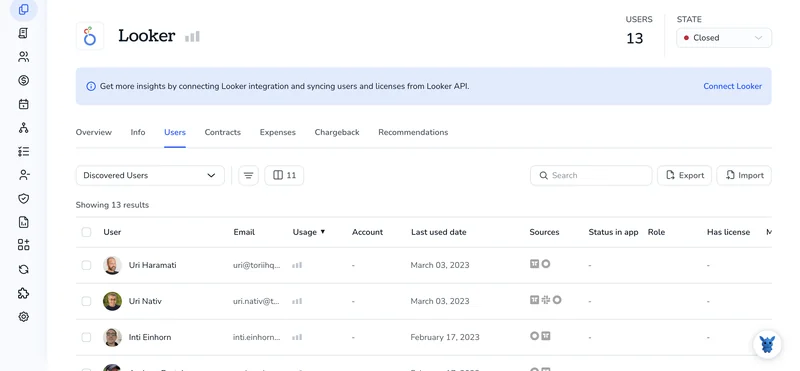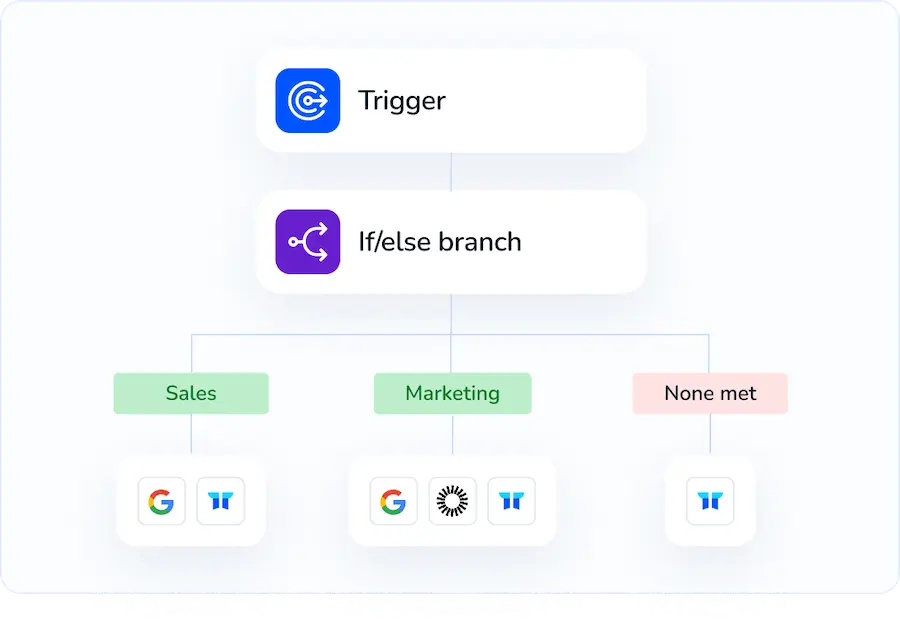3 Ways to Find License Counts in Looker

Keeping track of user licenses in Looker can feel like guessing in the dark. Seats shift as teams grow, proofs of compliance loom, and suddenly you need hard numbers.
This guide breaks down three straightforward ways to find and report license counts so admins see who sits where. Follow along, pick the method that fits your setup, and stay audit-ready.
Table of Contents
Use Looker’s UI
Use the Looker UI to check how many paid seats are active and who holds them.
Step 1: Open the Admin panel
- Click your avatar in the top-right corner.
- Pick Admin from the dropdown.
Step 2: Go to Usage
- In the left sidebar, scroll to the Platform section.
- Select Usage.
Looker opens a dashboard page that tracks system activity, performance details, and current license counts for the whole workspace.
Step 3: Read the license banner
- At the top of the page, find the card labeled Looker license usage.
- The line that starts with “Seats used” shows a count such as
42 of 50. That’s the live tally of licenses in use against your contract limit. - If your contract includes different seat types (Viewer, Standard, Developer), they appear in smaller text right below the total.
Step 4: Drill into the user list (optional)
- Click See user breakdown on the same card.
- A modal lists every active user, the seat type applied to them, and the role that’s driving that seat.
- Use the search bar at the top of the modal to find specific users or sort by seat type to spot heavy roles.
Step 5: Capture the numbers (optional)
- For a quick share, take a screenshot of the license banner.
- Need something more permanent? Hit Download CSV in the modal’s upper-right corner to export the breakdown.
With those steps finished, you have a clear view of seat usage right inside Looker. No extra tools required.
Use Torii
Skipping a direct pull from Looker, you can grab the license count through Torii, a SaaS Management Platform (SMP). An SMP gives your team one hub for every SaaS subscription and integration, streamlining user provisioning, deprovisioning, and subscription reviews.
Since Torii was designed for automation, the job runs the moment a defined event occurs, removing manual steps in Looker. Typical triggers include onboarding a new employee, offboarding someone who’s leaving, or an upcoming contract renewal. Automating these recurring tasks frees up valuable time.
To capture your Looker license count through Torii, follow the steps below:
1. Sign up for Torii
Reach out to Torii Sales and ask for a complimentary two-week proof of concept so you can test the platform.
2. Connect your Looker account to Torii
After your Torii tenant is set up, link your existing Looker workspace right from the integrations panel. Follow the directions in the official Looker integration guide.
3. Create a Torii workflow for Looker
Within Torii, build a workflow that retrieves the Looker license count. Go to the Workflows tab, choose a trigger, and add an action that pulls the license information from Looker. Once configured, the workflow fires whenever the trigger criteria are met, keeping your license data up to date automatically.

Use Looker’s API
This guide walks through authenticating with the Looker API, fetching every enabled user, and counting active seats.
1. Gather your API3 keys
Make sure you have a client ID and secret with permission to call the Looker API. Store both as environment variables instead of hard-coding them in scripts.
export LOOKER_CLIENT_ID="abc123"
export LOOKER_CLIENT_SECRET="xyz456"
export LOOKER_BASE_URL="https://yourcompany.looker.com:19999/api/4.0"
2. Exchange keys for a token
Send a POST request to /login, and Looker returns an access token.
TOKEN=$(curl -s -X POST "$LOOKER_BASE_URL/login" \
-D "client_id=$LOOKER_CLIENT_ID&client_secret=$LOOKER_CLIENT_SECRET" jq -r .access_token)
The response also includes expires_in, which tells you when to refresh the token.
3. Pull only enabled users
Disabled accounts don’t consume seats, so filter them out in the request by hitting /users/search with is_disabled=false.
curl -s -G "$LOOKER_BASE_URL/users/search" \
-D "is_disabled=false" \
-D "limit=1000" \
-D "fields=id" \
-H "Authorization: token $TOKEN" > users.json
If the instance holds more than 1,000 users, loop with offset or increase the limit value.
4. Count the results
Choose any parsing tool you prefer; the snippet below demonstrates a quick Bash example:
LICENSE_COUNT=$(jq length users.json)
echo "Active license count: $LICENSE_COUNT"
5. (Optional) End the session
When you finish, end the session by calling /logout and the API immediately invalidates the token you just used.
curl -s -X DELETE "$LOOKER_BASE_URL/logout" -H "Authorization: token $TOKEN"
With those steps complete, you have a repeatable script that reports how many active Looker licenses are in use.
Torii for SaaS Management
If your team juggles dozens of cloud tools, Torii can bring order without adding extra work. Reach out to see how the platform helps you
- Uncover shadow IT: AI scans usage data around the clock and flags unapproved apps the moment they appear.
- Trim expenses: Cut waste by cancelling idle seats and redundant tools before the bill hits.
- Automate onboarding/offboarding: Tie joiner and leaver tasks to workflows that run themselves, saving hours and avoiding manual errors.
- Receive proactive renewal reminders: Contract reminders arrive well before renewal, giving you time to renegotiate or walk away.
Torii delivers the first comprehensive SaaS Management Platform, giving Finance, IT, and Security one definitive view of your application landscape.
For details, case studies, and a quick demo, visit Torii.
Frequently Asked Questions
You have three straightforward options to surface seat totals: read the "Looker license usage" card inside Admin → Usage, export counts automatically via a Torii workflow, or call the Looker API to count enabled users. Pick the method that best fits your stack.
Yes. On the same license banner, click "See user breakdown" to open a modal listing every active account, the seat type assigned, and the role responsible. You can search, sort by seat, and even export the list as CSV.
After connecting your Looker workspace, build a Torii workflow that triggers on events such as onboarding, offboarding, or contract renewal. The workflow calls Looker, retrieves current seat counts, and logs or alerts stakeholders automatically—removing manual clicks and keeping audit data fresh.
Authenticate via /login to obtain a token, then call /users/search with is_disabled=false to return only enabled accounts. Parse the resulting list—often with jq—to calculate the seat count, and optionally end the session by hitting /logout.
No. Seats are allocated only to enabled users. When you disable an account it immediately frees the license, which is why API queries and UI dashboards exclude users where "is_disabled" equals true from the seat calculation.
Torii uncovers shadow IT by scanning usage data, cuts spend by flagging idle seats and redundant apps, automates onboarding and offboarding tasks, and sends proactive renewal reminders—giving Finance, IT, and Security one real-time view of your entire application landscape.

